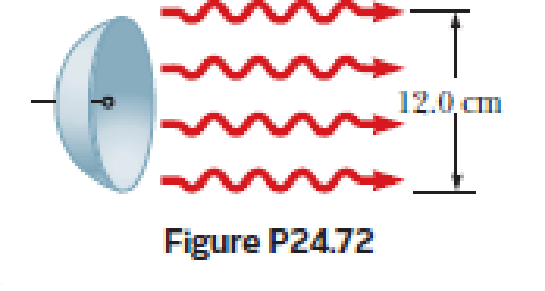
A microwave source produces pulses of 20.0-GHz

(a)
The wavelength of the microwave.
Answer to Problem 72P
The wavelength is
Explanation of Solution
Write the expression to calculate the wavelength.
Here,
Conclusion:
Substitute
Thus, the wavelength is
(b)
The total energy of each pulse.
Answer to Problem 72P
The total energy is
Explanation of Solution
Write the expression to calculate the total energy.
Here, U is the total energy, P is the power and t is the time.
Conclusion:
Substitute
Thus, the total energy is
(c)
The average energy density inside the pulse.
Answer to Problem 72P
The average energy density is
Explanation of Solution
Write the expression to calculate the average energy density.
Here, u is the average energy density, r is the radius and l is the length of the pulse.
Write the expression to calculate the length of the pulse.
Use the expression
Conclusion:
Substitute
Thus, the average energy density is
(d)
The amplitude of electric and magnetic field.
Answer to Problem 72P
The amplitude of electric and magnetic field respectively
Explanation of Solution
Write the expression to calculate the magnitude of electric field.
Here,
Write the expression to calculate the magnitude of magnetic field.
Here,
Conclusion:
Substitute
Substitute
Thus, the amplitude of electric and magnetic field respectively
(e)
The force exerted on the surface.
Answer to Problem 72P
The force exerted on the surface is
Explanation of Solution
Write the expression to calculate the force exerted on the surface.
Here, F is the force and A is the area.
Write the expression to calculate the area.
Use the above equation to rewrite the equation for F.
Conclusion:
Substitute
Thus, the force exerted on the surface is
Want to see more full solutions like this?
Chapter 24 Solutions
Bundle: Principles of Physics: A Calculus-Based Text, 5th + WebAssign Printed Access Card for Serway/Jewett's Principles of Physics: A Calculus-Based Text, 5th Edition, Multi-Term
- Thank you in advance, image with question is attached below.arrow_forwardQuestion is attached, thank you.arrow_forwardTwo very small spheres are initially neutral and separated by a distance of 0.612 m. Suppose that 4.12 × 1013 electrons are removed from one sphere and placed on the other. (a) What is the magnitude of the electrostatic force that acts on each sphere? (b) Is the force attractive or repulsive?arrow_forward
- Estimate the diameter of the Moon. During a total solar eclipse, the Moon passes in front of the Sun so that during “totality” their apparent sizes match and the Moon blocks light from the Sun shining on the Earth. a) What do you predict the size of the Moon would be if you were to use a pinhole in an aluminum holder, meter stick, and white paper screen to project light from the full Moon through a pinhole onto a screen that is one meter away from the pinhole? b) Describe in detail how you would use this apparatus and your knowledge of pinhole phenomena to estimate the diameter of the Moon. Assume that the distance between the Earth and the Moon is 250,000 miles.arrow_forwardThe following data was collected for a friction experiment in which an object was observed moving at constant speed over a surface. Graph the Applied Force versus the Normal Force and determine the coefficient of friction. Is this value the coefficient of kinetic friction or the coefficient of static friction? Justify your answer. Trial Normal Force Applied Force 1 4.13 1.44 2 6.41 1.68 3 8.94 2.82 4 11.34 3.94 5 13.82 5.05arrow_forward1. Measurements and Linear Regression 1.1 Introduction The objective of this lab assignment is to represent measurement data in graphical form in order to illustrate experimental data and uncertainty visually. It is often convenient to represent experimental data graphically, not only for reporting results but also to compute or measure several physical parameters. For example, consider two physical quantities represented by x and y that are linearly related according to the algebraic relationship, y=mx+b, (1.1) where m is the slope of the line and b is the y-intercept. In order to assess the linearity between y and x, it is convenient to plot these quantities in a y versus x graph, as shown in Figure 1.1. Datapoints Line of regression Figure 1.1: Best fit line example. Once the data points are plotted, it is necessary to draw a "best fit line" or "regression line" that describes the data. A best fit line is a straight line that is the best approximation of the given set of data, and…arrow_forward
- Please help with Statistical Analysis table. These are trials from a Newton's Laws of Motion lab, please help with standard deviation and margin of error. Thanks!arrow_forwardplease solve and answer the question correctly. thank you!!arrow_forwardplease solve and answer the question correctly. thank you!!arrow_forward
 Principles of Physics: A Calculus-Based TextPhysicsISBN:9781133104261Author:Raymond A. Serway, John W. JewettPublisher:Cengage Learning
Principles of Physics: A Calculus-Based TextPhysicsISBN:9781133104261Author:Raymond A. Serway, John W. JewettPublisher:Cengage Learning Physics for Scientists and Engineers: Foundations...PhysicsISBN:9781133939146Author:Katz, Debora M.Publisher:Cengage Learning
Physics for Scientists and Engineers: Foundations...PhysicsISBN:9781133939146Author:Katz, Debora M.Publisher:Cengage Learning Physics for Scientists and Engineers, Technology ...PhysicsISBN:9781305116399Author:Raymond A. Serway, John W. JewettPublisher:Cengage Learning
Physics for Scientists and Engineers, Technology ...PhysicsISBN:9781305116399Author:Raymond A. Serway, John W. JewettPublisher:Cengage Learning
 Glencoe Physics: Principles and Problems, Student...PhysicsISBN:9780078807213Author:Paul W. ZitzewitzPublisher:Glencoe/McGraw-Hill
Glencoe Physics: Principles and Problems, Student...PhysicsISBN:9780078807213Author:Paul W. ZitzewitzPublisher:Glencoe/McGraw-Hill College PhysicsPhysicsISBN:9781938168000Author:Paul Peter Urone, Roger HinrichsPublisher:OpenStax College
College PhysicsPhysicsISBN:9781938168000Author:Paul Peter Urone, Roger HinrichsPublisher:OpenStax College





